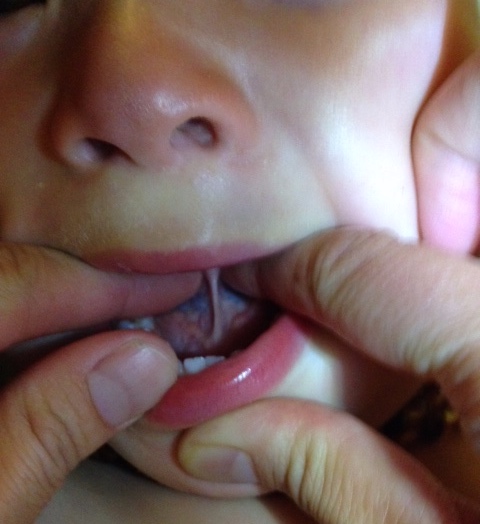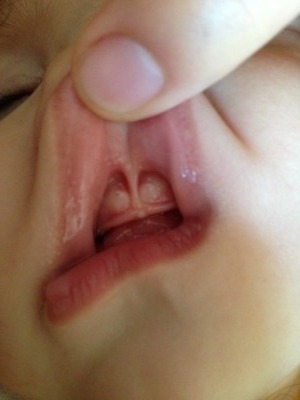Are Tongue and Lip Ties Being Overdiagnosed and Overtreated?
Written by Robin Kaplan, M.Ed, IBCLC, Owner of San Diego Breastfeeding Center
That has been the million dollar question of the week. Since Rachel Cautero published her article in the Atlantic last week about this topic, conversations about tethered oral tissue (TOTs) have had a resurgence of epic proportion. To discuss this topic, I was interviewed by Meghna Chakrabarti on NPR’s On Point this week. Her interview, entitled To Improve Breastfeeding, Babies Get Their Tongues Clipped. Is it necessary?, included the Atlantic journalist (Rachel Cautero), a pediatric ENT from John Hopkins (Dr. Jonathan Walsh), and me, an IBCLC from San Diego.
I encourage you to listen to this interview, as there were many important issues brought up that parents need to hear. I also encourage you to consider listening through an unbiased lens, as the first 30 minutes are fairly skewed due to the sharing of personal breastfeeding experiences by Meghna and Rachel. They talk about being informed of their infants’ tongue ties during a very vulnerable early postpartum period and how upsetting this information was to them. They shared how they both decided to stick with breastfeeding, despite significant pain for weeks and months, instead of considering a tongue tie release. And they both ended up finding that breastfeeding eventually got better and that they felt frustrated with all of the discussions online about tongue tie and upper lip tie releases, which they feel is being sold as the ‘cure-all’ to lactation woes.
Keep in mind….these are just two individuals’ stories out of many. We all have our personal stories of parenthood/breastfeeding/labor, etc that skew the way we view a situation because they evoke an emotional response in us. These emotional reactions are normal, but are that person’s point of view.
What I would like to share are the most pertinent points about tethered oral tissue (TOTs) that were shared in this interview, as well as a few more that weren’t shared due to time constraints.
4 Main Take-Aways about Tethered Oral Tissue (TOTs)
Tethered oral tissue can restrict range of motion in the tongue, lips, and cheeks
All people have frenulums, but to have tethered oral tissue (TOTs) means that the frenulum is restricting range of motion and impacting function. Here is a handout that includes many of the symptoms that can be related to TOTs.
These TOTs do not stretch over time, but some children/adults learn to compensate despite the tightness. This is why some children and adults don’t show or feel that they have long-term complications.
Releasing restricted frenula can have a profoundly positive effect on both parent and baby and their ability to meet their breastfeeding goals, but is not always necessary.
International Board Certified Lactation Consultants (IBCLCs) identify tethered oral tissue at a higher rate than pediatricians/ENTs because they are the professionals completing full oral/feeding assessments.
IBCLC assessments are not 15 minute well-baby checks. They are extensive assessments, lasting 1-3 hours, using research-supported evaluation tools.
TOTs cannot be evaluated just by looking in the mouth or at a photo of the mouth, tongue, and lip. Function must be taken into account.
Parents should be walked through each part of the oral/feeding assessment so that they can make an informed decision about what is best for their child.
It is always necessary to go back to basics (positioning and latch) first, before blaming a tongue or lip tie. If the symptoms for the breastfeeding parent or baby are not relieved with the basics, then further assessment is necessary.
Parents should be presented with a menu of options: bodywork (CST/PT/OT/Chiro, etc); oral exercises; tummy time; supplementing; exclusive pumping, etc. - everyone deserves to be supported regardless of their decisions.
There has been an increase of identification of and recommendation to release tethered oral tissue in the past two decades, with good reason
Increased research and ultrasound investigation on how the tongue and lips function while feeding have shown what is necessary to achieve comfortable, effective breastfeeding and milk removal. This information was not available until the past two decades.
There has been a shift in the international culture to be more pro-breastfeeding than it was during the 1900s. It is unfortunate that some families feel ‘pressured to breastfeed’, as Rachel mentioned in the interview. Personally, I think this shift in societal views towards breastfeeding has more to do with current research identifying the vast health-promoting and immunological benefits to mom and baby when breastfeeding, rather than parents feeling pressured to breastfeed.
TOTs are nothing new. Tongue ties and frenotomy descriptions can be found in early Japanese writings, other historical documents, and even the bible. In the 1600s, frenotomy was widely known and there is documentation that describes that midwives would keep one fingernail long and sharp so that she could release the tight frenulum without the use of an instrument.
In the early 1900s, formula was advertised as better than breastmilk and breastfeeding was considered as something that only impoverished people do. Up until then, if a mother could not breastfeed her baby, the family hired a wet nurse or the baby would die due to lack of nourishment. Formula changed the way we looked at infant nutrition and breastfeeding, which meant tethered oral tissue wasn’t viewed as important to address. With this pendulum shift to positive views about breastfeeding, parents want answers when challenges arise. And many of these challenges can be attributed to TOTs.
There is a lack of evidence specifically studying the long term effects of tethered oral tissue (TOTs)
There are several case studies and randomized control studies on how frenotomies improve breastfeeding outcome.
There are some correlations between TOTs and challenges eating solid foods, speech and change in oral/dental structure, but there is only a small amount of research to back this up. We clearly need more research.
What we do know is that children with TOTs often mouth breathe, which is widely recognized as pathological and may lead to:
open-mouth posture, which can block the airway when sleeping, leading to bruxism, snoring, sleep apnea
impaired swallowing, which can lead to a palate that doesn’t naturally expand and Eustchian tubes not opening and equalizing pressure in the middle ear
So, what’s the overall take away message?
When a family has breastfeeding challenges and doesn’t receive a comprehensive oral/feeding assessment that evaluates tongue and lip function, then we run the risk of tongue/lip ties being overdiagnosed and overtreated.
For more information about tethered oral tissue, check out these resources:
SOS for TOTs by Lawrence Kotlow, DDS
Tongue-Tied by Richard Baxter, DMD, MS
Kellymom: Breastfeeding a Baby with a Tongue Tie or Lip Tie (Resources)
Tongue tie articles on SDBFC’s website


